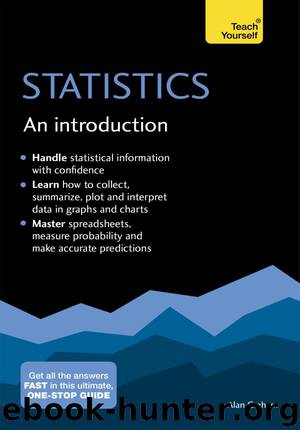Statistics: An Introduction: Teach Yourself: The Easy Way to Learn Stats by Alan Graham

Author:Alan Graham [Graham, Alan]
Language: eng
Format: epub
Tags: Business & Economics, Mathematics, Probability & Statistics, Statistics
ISBN: 9781473652019
Google: EfcZDQAAQBAJ
Amazon: B01LX38WO0
Publisher: Hodder & Stoughton
Published: 2017-04-06T03:00:00+00:00
Human error and sampling error
I reckon the light in my ‘fridge’ must stay on all the time. I’ve checked hundreds of times and every time I open the door to have a look it is still on!
One of the dilemmas for any researcher is that he or she never really knows the extent to which their research observations affect or disturb the objects or people being observed. As with the ‘opening the “fridge” door’ example above, all surveys involve opening some sort of door on people’s lives. Observers participate in this process and can never fully know the extent to which their presence has affected the phenomena that are being presented to them. All they can do is attempt to monitor their findings against those collected in a different way and then try to account for any differences. Most of all, the observer needs to be sensitive to these questions and make every attempt to tread lightly.
There are two main types of error that surround sampling. The first is the sort introduced by a badly designed sampling procedure, and some examples of these have been given earlier in the chapter. This might be called ‘human error’. Sometimes error is deliberately and unfairly introduced into the sampling process in order to distort the findings. Examples of this are the original polls which were used to compile the pop music charts. The first singles chart, known as the Record Hit Parade, was released in 1952 and was published by the New Musical Express . (Before that, the charts were compiled from sheet music sales.)
In those early days, a small number of record shops were selected and sampled for their record sales over the previous week. The problem was that the sample size was small and, once the identity of a ‘chart shop’ became known, agents would descend with wads of fivers to buy particular records and thereby bump up their chart ratings. This problem was tackled by increasing the number of ‘chart shops’, and the Gallup polling agency responsible for compiling the charts subsequently sampled from around 1000, or roughly one in four of all music outlets.
Phone-in polls were a popular means by which some radio stations compiled record charts, but these are even more open to distortion than sampling sales from record outlets. In 1986, when Capital Radio decided to compile the all-time Top 100 records, based on a listeners’ phone-in poll, five Bros records featured in the chart. This probably says something about the promotional zeal of the listening ‘Brosettes’ and the fact that a phone call or ten costs less than the price of a single, particularly if mummy and daddy are footing the telephone bill.
Let us now turn to the second form of error, known as ‘sampling error’. Due to natural variation, all sampling is inherently prone to variation that is an inevitable part of the random sampling process. It is this type of error that was first mentioned earlier in this chapter in the section headed ‘Sampling variation’.
Download
This site does not store any files on its server. We only index and link to content provided by other sites. Please contact the content providers to delete copyright contents if any and email us, we'll remove relevant links or contents immediately.
| Biomathematics | Differential Equations |
| Game Theory | Graph Theory |
| Linear Programming | Probability & Statistics |
| Statistics | Stochastic Modeling |
| Vector Analysis |
Weapons of Math Destruction by Cathy O'Neil(5037)
Factfulness: Ten Reasons We're Wrong About the World – and Why Things Are Better Than You Think by Hans Rosling(4022)
Factfulness_Ten Reasons We're Wrong About the World_and Why Things Are Better Than You Think by Hans Rosling(2754)
Descartes' Error by Antonio Damasio(2731)
A Mind For Numbers: How to Excel at Math and Science (Even If You Flunked Algebra) by Barbara Oakley(2691)
TCP IP by Todd Lammle(2639)
Applied Predictive Modeling by Max Kuhn & Kjell Johnson(2479)
Fooled by Randomness: The Hidden Role of Chance in Life and in the Markets by Nassim Nicholas Taleb(2413)
The Book of Numbers by Peter Bentley(2404)
The Tyranny of Metrics by Jerry Z. Muller(2401)
The Great Unknown by Marcus du Sautoy(2186)
Once Upon an Algorithm by Martin Erwig(2149)
Easy Algebra Step-by-Step by Sandra Luna McCune(2117)
Practical Guide To Principal Component Methods in R (Multivariate Analysis Book 2) by Alboukadel Kassambara(2093)
Lady Luck by Kristen Ashley(2073)
Police Exams Prep 2018-2019 by Kaplan Test Prep(2033)
Linear Time-Invariant Systems, Behaviors and Modules by Ulrich Oberst & Martin Scheicher & Ingrid Scheicher(1983)
All Things Reconsidered by Bill Thompson III(1960)
Secrets of Creation, Volume 1: The Mystery of the Prime Numbers by Watkins Matthew(1864)
